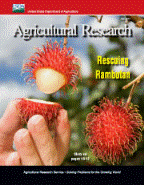United States Department of Agriculture: Agricultural Research Service, Lincoln, Nebraska

Agricultural Research Magazine
Date of this Version
1-2013
Document Type
Article
Citation
Agricultural Research January 2013.
Abstract
The brown marmorated stink bug (BMSB) is wreaking havoc in U.S. homes, gardens, and agricultural operations, causing personal and economic woe. Agricultural Research Service scientists are exploring various aspects of monitoring and control of this increasingly important insect pest, which is an invasive Asian species known as a sporadic pest of many tree fruit crops in China, Korea, and Japan. Along with being a household nuisance, it is a major economic threat to producers of orchard fruits such as apple, peach, and pear; garden vegetables and row crops; and many ornamental species.
Since its detection in the northeastern United States a decade ago, the BMSB has been detected in 38 states and has earned the distinction of being classified as the top invasive insect of interest by the U.S Department of Agriculture. With economic losses to the apple industry estimated at $37 million in 2010, the bug’s threat to apple growers prompted a Member of Congress to organize a public hearing in western Maryland. There is also concern about the potential damage it could cause to vineyards in California and other states.
Tracy Leskey, with the Appalachian Fruit Research Station in Kearneysville, West Virginia, is the principal investigator of the research group, which includes several scientists in ARS’s Invasive Insect Biocontrol and Behavior Laboratory in Beltsville, Maryland; Jana Lee, an ARS entomologist in Corvallis, Oregon; and Kim Hoelmer, director of the USDA-ARS European Biological Control Laboratory in Montpellier, France.
Included in
Agriculture Commons, Animal Sciences Commons, Food Science Commons, Plant Sciences Commons

